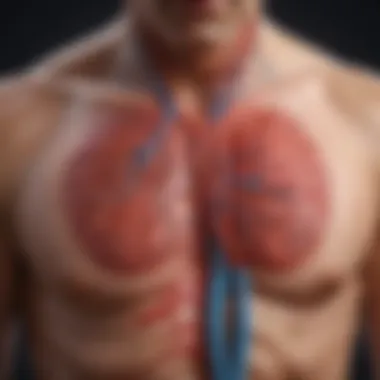Cholesterol and Blood Pressure: An In-Depth Analysis


Intro
Cholesterol and blood pressure are two critical components of cardiovascular health. Their intricate relationship influences overall well-being and is a focal point of numerous studies. Understanding how these two elements interplay can lead to better management strategies and improved health outcomes.
In this article, we will dissect cholesterol types, their roles in the body, and how they relate to blood pressure. The discussion will also cover physiological mechanisms, clinical effects, and lifestyle influences.
This comprehensive overview will serve as a resource for educators, researchers, and anyone interested in enhancing their knowledge on these topics. The insights drawn from current research will pave the way for future advancements in cardiology and nutrition.
Methodology
Overview of research methods used
The research for this article involved a systematic review of current literature focusing on cholesterol and blood pressure. Several peer-reviewed journals were consulted to gather relevant data, ensuring a robust foundation for understanding the topic.
Data collection techniques
Data was collected through the following methods:
- Literature review: Analyzing existing studies on cholesterol's impact on blood pressure.
- Clinical trials: Evaluating evidence from recent clinical trials and public health studies.
- Surveys: Reviewing surveys that assess lifestyle factors affecting cardiovascular health.
By combining these techniques, a comprehensive perspective emerged regarding cholesterol and blood pressure.
Understanding Cholesterol
Cholesterol is a waxy substance found in every cell of the body. It plays vital roles, including providing structure to cell membranes and serving as a precursor for hormone production. Cholesterol is classified into different types, primarily low-density lipoprotein (LDL) and high-density lipoprotein (HDL).
- LDL is often termed "bad cholesterol" as high levels can lead to plaque buildup in arteries, increasing the risk of hypertension.
- HDL is known as "good cholesterol" because it helps transport cholesterol away from arteries, potentially reducing cardiovascular risk.
The Role of Blood Pressure in Cardiovascular Health
Blood pressure is the force exerted by circulating blood on the walls of blood vessels. It is measured in millimeters of mercury (mmHg) and is expressed with two numbers: systolic and diastolic pressure. Maintaining optimal blood pressure levels is essential for reducing the risk of heart disease and stroke.
Hypertension and Its Effects on the Body
Hypertension, or high blood pressure, is a significant risk factor for cardiovascular issues. It can lead to damage in blood vessels, increasing the risk of heart attacks and strokes. The relationship between cholesterol and hypertension is complex, as elevated cholesterol can contribute to increased blood pressure levels.
Lifestyle Factors Affecting Cholesterol and Blood Pressure
Several lifestyle factors can influence both cholesterol levels and blood pressure. Key elements include:
- Diet: Diets high in saturated fats can raise LDL cholesterol. Foods rich in omega-3 fatty acids can improve cholesterol ratio.
- Exercise: Regular physical activity lowers cholesterol and supports healthy blood pressure levels.
- Smoking: Tobacco use can elevate blood pressure and diminish HDL cholesterol levels.
By managing these lifestyle factors, individuals can significantly improve their cardiovascular health.
"A healthy lifestyle is critical to maintaining optimal cholesterol and blood pressure levels."
Future Directions
Upcoming trends in research
Future research is likely to explore the genetic factors that underlie cholesterol levels and blood pressure. Scientists are increasingly interested in how personalized medicine can tailor interventions for individuals based on their specific profiles.
Areas requiring further investigation
There is a need for more studies on the long-term effects of dietary changes on cholesterol and blood pressure. Additionally, understanding the psychological factors influencing lifestyle choices could provide insights into more effective prevention and treatment strategies.
By comprehensively examining cholesterol and blood pressure, we can lay the groundwork for better health outcomes and informed future studies in cardiology and nutrition.
Understanding Cholesterol


Understanding cholesterol is crucial for grasping the complex interactions within our cardiovascular system. Cholesterol is often viewed negatively, yet it serves critical functions in bodily processes. Any analysis of health requires consideration of cholesterol, as it is a significant risk factor for many chronic conditions, including heart disease. An informed view can lead to better health strategies, reducing risks related to cholesterol and its impact on blood pressure.
Definition and Importance of Cholesterol
Cholesterol is a waxy substance produced by the liver and obtained from certain foods. It is essential for several functions, including the production of hormones, vitamin D, and substances that help digest foods. The importance of cholesterol cannot be overstated; it forms part of cell membranes and is necessary for cellular health. However, not all cholesterol is alik.
Types of Cholesterol: HDL and
There are two main types of cholesterol: low-density lipoprotein (LDL) and high-density lipoprotein (HDL). LDL is commonly referred to as "bad" cholesterol because high levels can lead to plaque buildup in arteries, increasing the risk of heart disease and stroke. Conversely, HDL is known as "good" cholesterol, as it helps transport cholesterol away from the arteries and back to the liver for removal from the body.
It's important to maintain a balance between these two types. An elevated level of LDL, coupled with low HDL, presents a significant health risk. Regular lipid profiling can help individuals monitor their cholesterol levels.
Role of Cholesterol in the Body
Cholesterol fulfills numerous roles in the human body. It aids in the formation of cell membranes, ensuring they remain fluid and functional. Additionally, cholesterol is a precursor for the synthesis of steroid hormones such as estrogen and testosterone. Its role in the nervous system is equally significant; cholesterol is vital for synthesizing myelin, the protective sheath around nerves that facilitates fast signaling.
Understanding Blood Pressure
In the context of cardiovascular health, understanding blood pressure is crucial. Blood pressure refers to the force of blood against the walls of arteries as the heart pumps it around the body. High blood pressure, or hypertension, can lead to serious health issues, including heart disease and stroke. This section will delve into the definition and measurement of blood pressure, the categories it falls under, and its vital role in maintaining overall cardiovascular health.
Definition and Measurement of Blood Pressure
Blood pressure is defined by two measurements: systolic and diastolic pressure. Systolic pressure is the force exerted when the heart beats, while diastolic pressure measures the force when the heart is at rest between beats. It is typically expressed in millimeters of mercury (mmHg) and written as systolic over diastolic, for example, 120/80 mmHg.
To measure blood pressure, a sphygmomanometer is often used, sometimes accompanied by a stethoscope for more accurate readings. This device inflates around the upper arm, restricting blood flow. As the cuff deflates, the healthcare professional listens for the sound of blood returning to the artery, marking the systolic and diastolic pressures.
Categories of Blood Pressure Levels
Blood pressure readings can be categorized into several levels, which are essential for diagnosing possible hypertension:
- Normal: Below 120/80 mmHg
- Elevated: Systolic between 120-129 and diastolic less than 80 mmHg
- Hypertension Stage 1: Systolic between 130-139 or diastolic between 80-89 mmHg
- Hypertension Stage 2: Systolic 140 or higher or diastolic 90 or higher
- Hypertensive Crisis: Systolic higher than 180 and/or diastolic higher than 120, requiring immediate medical attention
Understanding these categories helps both individuals and healthcare providers identify at-risk patients, fostering proactive measures to manage and lower high blood pressure when necessary.
Role of Blood Pressure in Cardiovascular Health
Blood pressure plays a significant role in cardiovascular health. It is not just a number; it reflects how well the heart and blood vessels function together. High blood pressure forces the heart to work harder to pump blood, which can lead to the thickening of heart muscles, heart failure, and other cardiovascular diseases.
Moreover, elevated blood pressure can damage blood vessels over time, leading to cholesterol build-up within the arteries, ultimately increasing the risk of heart attacks and strokes. Therefore, it is integral to monitor blood pressure regularly and maintain it within a healthy range.
Regular blood pressure monitoring is essential for preventing cardiovascular diseases and ensuring a longer, healthier life.
In summary, blood pressure is an indicator of how well the cardiovascular system operates. By understanding its definition, measurement techniques, and health implications, individuals can better navigate their path towards optimal heart health. This foundation sets the stage for exploring the connections between blood pressure and cholesterol levels, which will be examined in subsequent sections.
The Connection Between Cholesterol and Blood Pressure
The relationship between cholesterol and blood pressure is intricate and vital for understanding cardiovascular health. Both factors significantly affect each other and can lead to severe health outcomes, including heart disease and stroke. By examining this connection, individuals can gain insights into their health risks and the underlying reasons for changes in blood pressure or cholesterol levels. This section elucidates how these two elements intertwine, presenting relevant physiological mechanisms, the impact of cholesterol on blood pressure, and the role inflammation plays in this dynamic. Understanding these connections can inform patient care and preventive strategies.
Physiological Mechanisms Linking Cholesterol and Blood Pressure
Cholesterol is a lipid molecule present in all cell membranes and is crucial for hormonal production and cellular function. High levels of low-density lipoprotein (LDL) cholesterol lead to atherosclerosis, which involves plaque accumulation in the arterial walls. This thickens the arteries, raising blood pressure.
The following physiological mechanisms illustrate how cholesterol affects blood pressure:
- Vascular Resistance: Increased cholesterol reduces arterial elasticity, leading to higher resistance against blood flow.
- Endothelial Dysfunction: Atherosclerosis damages the endothelium, impairing its ability to regulate vascular tone and fluid balance, resulting in hypertension.
- Renin-Angiotensin System Activation: Dyslipidemia can stimulate the renin-angiotensin system that controls blood pressure regulation and fluid balance, contributing to hypertension development.
These factors combine to create a feedback loop where high cholesterol can elevate blood pressure, further exacerbating cardiovascular issues.
Impact of High Cholesterol on Blood Pressure Levels
Research indicates that high cholesterol significantly correlates with elevated blood pressure levels. When LDL cholesterol levels rise, the likelihood of hypertension also increases. This correlation is not just theoretical but backed by numerous studies showing that decreased cholesterol levels often lead to improved blood pressure readings. Key impacts can be summarized as follows:


- Increased Arterial Stiffness: LDL cholesterol contributes to arterial wall thickening, making blood vessels stiffer and less able to accommodate blood flow, leading to higher pressure.
- Plaque Formation: The buildup of cholesterol plaques narrows arteries, forcing the heart to work harder and increasing overall blood pressure.
- Increased Heart Rate: The body compensates for restricted blood flow, raising heart rate and ultimately increasing blood pressure.
Thus, managing cholesterol levels may be crucial for controlling blood pressure and improving cardiovascular health.
Role of Inflammation in Cholesterol and Blood Pressure Dynamics
Inflammation plays a critical role in both cholesterol metabolism and blood pressure regulation. Chronic inflammation is a condition often associated with high cholesterol levels, further complicating the dynamics of cardiovascular health. Some of the significant aspects include:
- Inflammatory Cytokines: Elevated cholesterol promotes inflammation that leads to the release of cytokines. These substances can lead to vascular damage, increasing blood pressure.
- Insulin Resistance: Inflammation can cause insulin resistance, which is often linked to higher cholesterol levels and hypertension.
- Other Risk Factors: Conditions like obesity amplify inflammation, leading to a cycle where cholesterol and blood pressure levels negatively affect each other.
By addressing inflammation, whether through lifestyle changes or medications, it is possible to positively influence cholesterol levels and blood pressure, ultimately benefiting cardiovascular health.
Understanding the link between cholesterol and blood pressure is vital for developing effective strategies for prevention and management, paving the way for improved health outcomes.
Clinical Implications
Understanding the clinical implications of cholesterol and blood pressure is crucial for effective management of cardiovascular health. The interaction between these two factors can lead to significant health issues if not properly addressed. Recognizing the consequences of dysregulated levels is essential for preventing cardiac events and ensuring timely intervention.
Consequences of Dysregulated Cholesterol and Blood Pressure
Dysregulated cholesterol and blood pressure levels can have far-reaching consequences for an individual's health. High levels of low-density lipoprotein (LDL) cholesterol, often referred to as "bad cholesterol," can lead to arterial plaque buildup. This buildup can obstruct blood flow, resulting in hypertension or elevted blood pressure. When blood pressure is consistently high, it exerts excessive force on the arteries, which can lead to damage over time.
Moreover, individuals with both high cholesterol and high blood pressure are at a higher risk for serious cardiovascular events. These may include coronary artery disease, heart attack, and stroke. Recognizing these relationships can guide healthcare providers in developing appropriate treatment plans.
Risk Factors for Cardiac Events
Several risk factors contribute to the likelihood of cardiac events associated with high cholesterol and blood pressure. Some of these include:
- Age: The risk increases with age, as blood vessels naturally decline in elasticity.
- Family History: Genetic predisposition plays a role in cholesterol metabolism and blood pressure regulation.
- Lifestyle Choices: Unhealthy diets, sedentary lifestyles, and smoking can contribute significantly.
- Obesity: Excess body weight is linked to higher cholesterol levels and increased blood pressure.
- Comorbid Conditions: Conditions like diabetes can exacerbate risks associated with cardiovascular health.
Monitoring these risk factors is vital for proactive management strategies.
Screening and Monitoring Recommendations
Regular screening and monitoring are essential for maintaining optimal levels of cholesterol and blood pressure. Health professionals recommend the following:
- Routine Check-Ups: Annual check-ups are ideal for monitoring blood pressure and cholesterol levels, especially for those over 40 years old or with risk factors.
- Blood Tests: Lipid panels should be conducted to measure cholesterol levels anually or biennially, depending on individual risk assessments.
- Home Monitoring Devices: Patients can benefit from using home blood pressure monitors to keep track of their cardiovascular status.
Regular monitoring can significantly improve outcomes and reduce the incidence of cardiac events by facilitating early intervention and personalized treatment plans.
Management Strategies
Management strategies for cholesterol and blood pressure are pivotal for optimizing cardiovascular health. An integrated approach allows individuals to maintain or improve their health metrics effectively. Effective management not only reduces the risk of severe complications but also improves the overall quality of life. It combines lifestyle changes, medical advice, and continuous monitoring. By understanding the options available, individuals can make informed decisions about their health.
Dietary Influences on Cholesterol and Blood Pressure
Diet plays a crucial role in managing cholesterol and blood pressure levels. Consuming a heart-healthy diet can significantly lower LDL cholesterol and help maintain normal blood pressure. Key components include:
- Fruits and Vegetables: High in vitamins, minerals, and fiber, they can contribute to healthier blood pressure levels.
- Whole Grains: Foods such as oatmeal, brown rice, and whole grain bread provide fiber that helps lower cholesterol.
- Healthy Fats: Incorporating sources like avocados, olives, and fatty fish can improve cholesterol profiles.
- Limit Saturated and Trans Fats: Reducing the intake of red meat and processed foods can lead to better heart health.
Additionally, monitoring sodium intake is essential for blood pressure management. A low-sodium diet can help in reducing hypertension. It's also important to maintain healthy hydration habits.
Physical Activity and Its Effects
Engaging in regular physical activity is a fundamental strategy for managing cholesterol and blood pressure. Exercise contributes to:
- Lowering LDL Levels: Moderate or vigorous physical activity can help raise HDL cholesterol, the 'good' type.
- Weight Management: Regular activity assists in controlling body weight, which directly impacts blood pressure and cholesterol levels.
- Improving Overall Cardiovascular Health: Activities like walking, cycling, and swimming can strengthen the heart and improve circulation.
The American Heart Association recommends at least 150 minutes of moderate-intensity aerobic activity per week combined with muscle-strengthening activities on two or more days.


Pharmacological Interventions
Pharmacological interventions are sometimes necessary for managing high cholesterol and blood pressure, particularly when lifestyle changes alone do not suffice. Common medications include:
- Statins: Such as atorvastatin and simvastatin, primarily aimed at lowering LDL cholesterol.
- ACE Inhibitors: Such as lisinopril, these are frequently used to manage blood pressure effectively.
- Diuretics: Can help reduce blood pressure by eliminating excess fluid.
Regular check-ups with healthcare providers are important to evaluate the effectiveness and side effects of medications. Adjustments to treatment may be needed based on individual medical conditions and responses.
The collaboration between patients and healthcare providers is crucial for successful management strategies that cater to individual needs.
The Role of Healthcare Providers
Healthcare providers play a crucial role in the management of cholesterol and blood pressure. With the prevalence of cardiovascular diseases rising globally, their expertise is vital in guiding patients through risk assessments, education, and collaborative care approaches. It is essential for healthcare professionals to understand the intricate interplay between cholesterol levels and blood pressure, enabling them to offer nuanced care tailored to individual patient needs.
Guidance on Risk Assessment and Calculation
Effective risk assessment begins with a comprehensive evaluation of both cholesterol and blood pressure levels. Healthcare providers utilize established guidelines to calculate risks of cardiovascular events. This includes measuring LDL and HDL cholesterol levels along with systolic and diastolic blood pressure. Special attention is given to:
- Family history of heart disease
- Lifestyle factors such as diet and exercise
- Concurrent medical conditions like diabetes or obesity
These factors help healthcare providers identify patients at increased risk, allowing for earlier interventions. Careful monitoring and regular screening can lead to positive outcomes by catching abnormalities before they become severe.
Importance of Patient Education
Patient education is essential in empowering individuals to take charge of their health. Providers should focus on conveying essential knowledge about how cholesterol and blood pressure relate to heart disease. Educational efforts can encompass:
- Understanding the basics of cholesterol and its types.
- Importance of maintaining normal blood pressure levels.
- How lifestyle modifications, such as diet and exercise, can significantly alter cholesterol and blood pressure outcomes.
When patients are informed, they are more likely to engage in proactive health behaviors. This engagement is critical in reducing cardiovascular risk factors and promoting general wellness.
Collaborative Care Framework
Healthcare providers often work within a collaborative care framework to address the complexities associated with managing cholesterol and blood pressure. This framework involves teamwork among various health professionals, including nutritionists, pharmacists, and mental health specialists. The benefits of this collaboration include:
- Enhanced patient support systems
- Shared decision-making that respects patient preferences
- Comprehensive management strategies for patients with co-morbidities
This model facilitates better communication among providers and ensures patients receive holistic care. With cardiovascular health being multifaceted, the inclusion of diverse expert opinions can lead to more effective treatment paths.
“A collaborative approach allows for a more rounded understanding of patient needs, which is essential in managing conditions like cholesterol variations and blood pressure.”
In summary, healthcare providers are fundamental in guiding patients through the complexities of cholesterol and blood pressure management. Their role encompasses risk assessment, education, and fostering collaborative efforts to ensure comprehensive care. Understanding these elements is crucial for improving patient outcomes and advancing cardiovascular health.
Future Directions in Research
The exploration of cholesterol and blood pressure is an evolving field. Future research directions open opportunities for deeper understanding and innovative management strategies. Addressing these areas is crucial due to the complex interplay of lifestyle, genetics, and environmental factors affecting cardiovascular health. Researchers face the challenge of optimizing treatment and prevention methods to reduce risk factors associated with high cholesterol and hypertension.
Innovative Approaches to Treatment
Research is increasingly focusing on personalized medicine. Tailoring treatment plans to the individual’s genetic profile may enhance patient outcomes. Incorporating genomic data allows for a better understanding of how genetics influence cholesterol levels and blood pressure responses. Additionally, new drug classes are in development. For instance, PCSK9 inhibitors have shown potential in significantly lowering LDL cholesterol levels. This represents a shift from traditional statin therapies, suggesting advancements in pharmacological treatment.
Ongoing studies are also examining the combination of lifestyle modification programs with pharmacological interventions. By integrating diet changes, exercise regimens, and medication, holistic approaches may yield better results than isolated treatments. These adaptations highlight the need for innovative strategies in managing conditions linked to cholesterol and blood pressure.
Longitudinal Studies on Cholesterol and Blood Pressure
Longitudinal studies are vital in understanding how cholesterol and blood pressure evolve over time within diverse populations. By monitoring these parameters in various demographic groups, it is possible to identify risk factors and health outcomes linked to chronic conditions. These studies provide data that can inform public health policies and individual clinical practices.
For example, research tracking participants over several years can disclose patterns in cholesterol management and blood pressure readings. Insights gained can help establish benchmarks for healthy levels and influence guidelines for monitoring at-risk populations. Furthermore, they can elucidate the long-term effects of lifestyle interventions, thus informing clinical recommendations.
Interdisciplinary Research Opportunities
The intersection of cardiology, endocrinology, nutrition, and other fields offers rich opportunities for innovative research. Collaborative efforts between disciplines can uncover comprehensive strategies for preventing and managing high cholesterol and hypertension.
For instance, incorporating nutrition science can enhance understanding of the dietary impacts on lipid profiles and blood pressure levels. Behavioral sciences also play a role, focusing on adherence to treatment plans and lifestyle choices. Exploring these interdisciplinary connections is vital for creating well-rounded interventions that can significantly improve patient health outcomes.
"The future of cardiovascular health relies on a multifaceted approach to research and treatment."
Integrating knowledge from various disciplines ensures a thorough investigation into the complexities of cholesterol and blood pressure. This may lead to breakthroughs in prevention and treatment strategies, ultimately benefiting patients globally.







